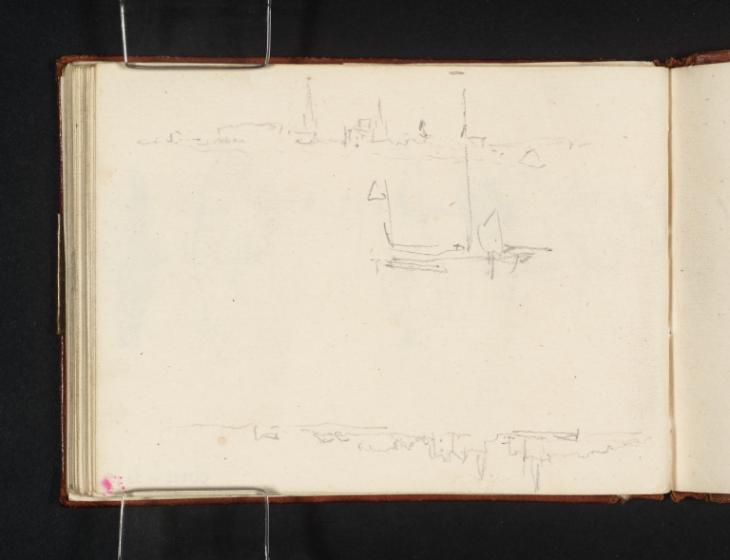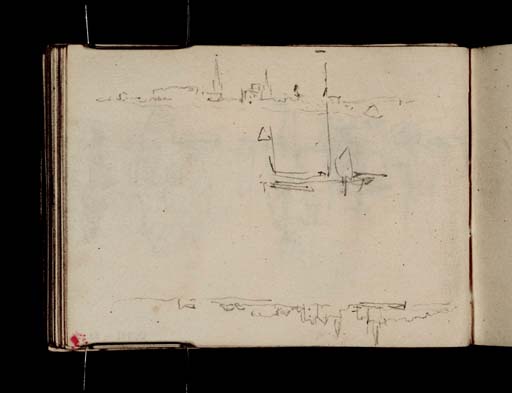Joseph Mallord William Turner Southampton from Southampton Water; a Sailing Boat 1827
Image 1 of 2
Joseph Mallord William Turner,
Southampton from Southampton Water; a Sailing Boat
1827
Joseph Mallord William Turner 1775–1851
Folio 58 Verso:
Southampton from Southampton Water; a Sailing Boat 1827
D18102
Turner Bequest CCVII 58a
Turner Bequest CCVII 58a
Pencil on white wove paper, 74 x 100 mm
Accepted by the nation as part of the Turner Bequest 1856
References
1909
A.J. Finberg, A Complete Inventory of the Drawings of the Turner Bequest, London 1909, vol.I, p.627, CCVII 58a, as ‘A vessel; also two groups of buildings, with trees’.
There are two slight views at the top and bottom, inverted relative to each other, showing similar distant prospects of Southampton, with its two church spires (for which see later in the text). Most of the drawings from here to folios 68 verso–69 recto (D18122–D18123) were made around the town (subsequently a city), an important Hampshire port on the banks of the River Test above its confluence with the River Itchen, forming Southampton Water, on the mainland some twelve miles north-west of Cowes. (For more on studies in this sketchbook relating to the regatta events at Cowes from late July 1827 onwards, see the sketchbook Introduction.) Finberg’s tentative identification of folios 61 verso–62 recto (D18108–D18109) as showing Southampton1 is the only one confirmed of the very few he made in the whole sketchbook. As the few subsequent pages include identified Cowes views, the Southampton sequence may represent a brief excursion during Turner’s extended stay on the island, taking in Calshot Castle on the Solent along the way (see folios 60 verso and 61 recto; D18106, D18107).
Southampton has seen immense change since Turner’s time, not least in the reclamation of large areas of the Test foreshore north-west of the old town walls for cruise-liner docks and other commercial developments.2 Bombing in the Second World War and subsequent rebuilding left little of the older fabric intact, except for some sections of the medieval walls and gate-towers. Turner’s views are characterised by two slender church spires, which appear to be those of St Michael’s, which still stands, and nearby Holyrood (or Holy Rood), of which only the tower survives intact. There is a view including these two spires across water in the 1795 Isle of Wight sketchbook (Tate D00418; Turner Bequest XXIV 12), as well as a study of the Bargate (Tate D00416; Turner Bequest XXIV 10). The later Guernsey sketchbook includes some slight studies (Tate D23541, D23571, D23573, D23604–D23605, D23607, D23644; Turner Bequest CCLII 11, 27a, 28a, 45a–46, 47, 65a). Compare also Edward Dayes’s Southampton from the Grounds of Cranbury Park (Tate D36346; Turner Bequest CCCLXXI D), the sepia watercolour by G.W. Gent (Tate T08908), and William Westall’s 1814 view for the Picturesque Views on the Southern Coast of England (Tate impressions: T05322, T05323).
Matthew Imms
December 2014
See the chronological sequence of aerial artist’s impressions at PortCities Southampton, accessed 15 December 2014, beginning at http://www.plimsoll.org/StartHere/PartnersAndCollections/SCCArchives/BurgessGallery/Burgess5.asp .
How to cite
Matthew Imms, ‘Southampton from Southampton Water; a Sailing Boat 1827 by Joseph Mallord William Turner’, catalogue entry, December 2014, in David Blayney Brown (ed.), J.M.W. Turner: Sketchbooks, Drawings and Watercolours, Tate Research Publication, November 2016, https://www


